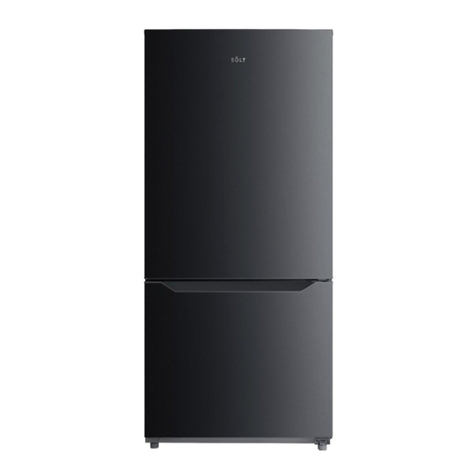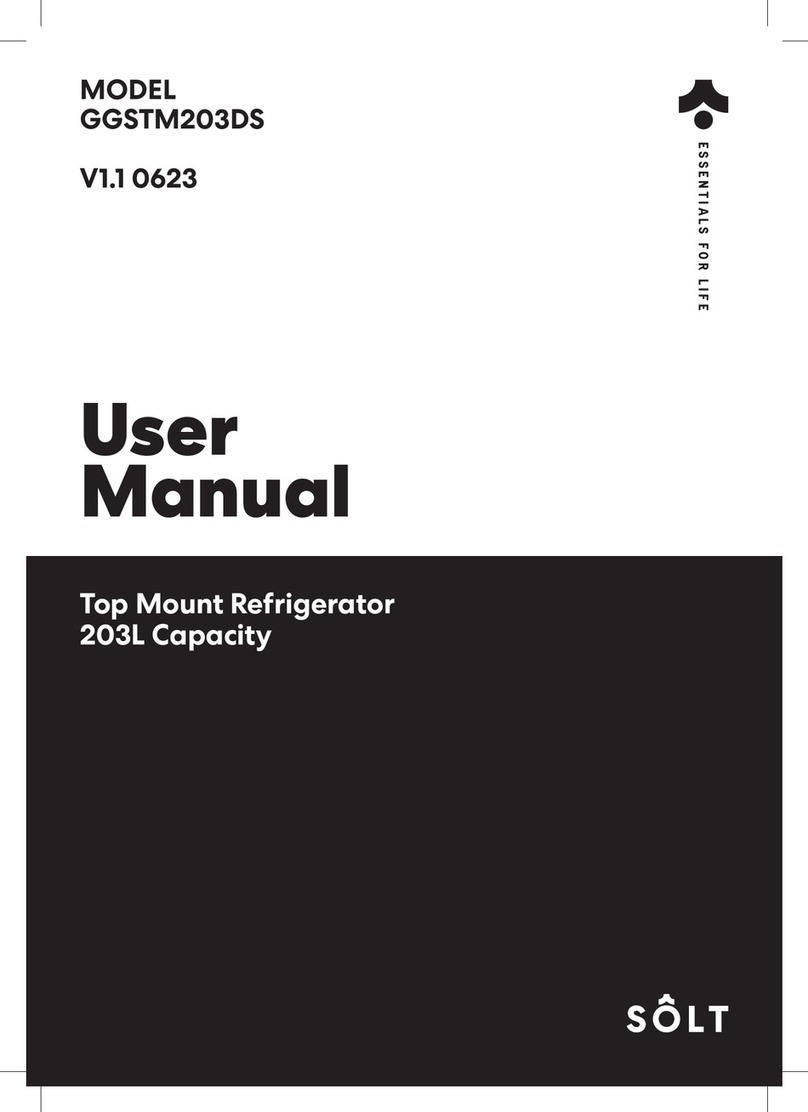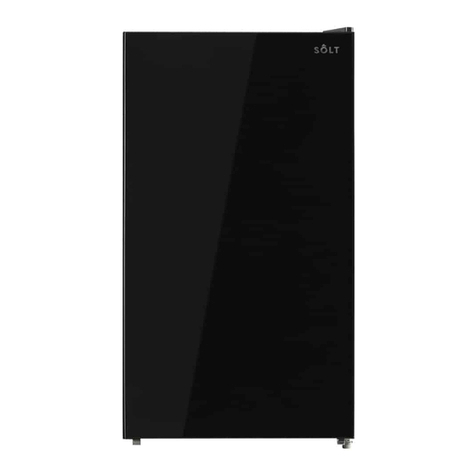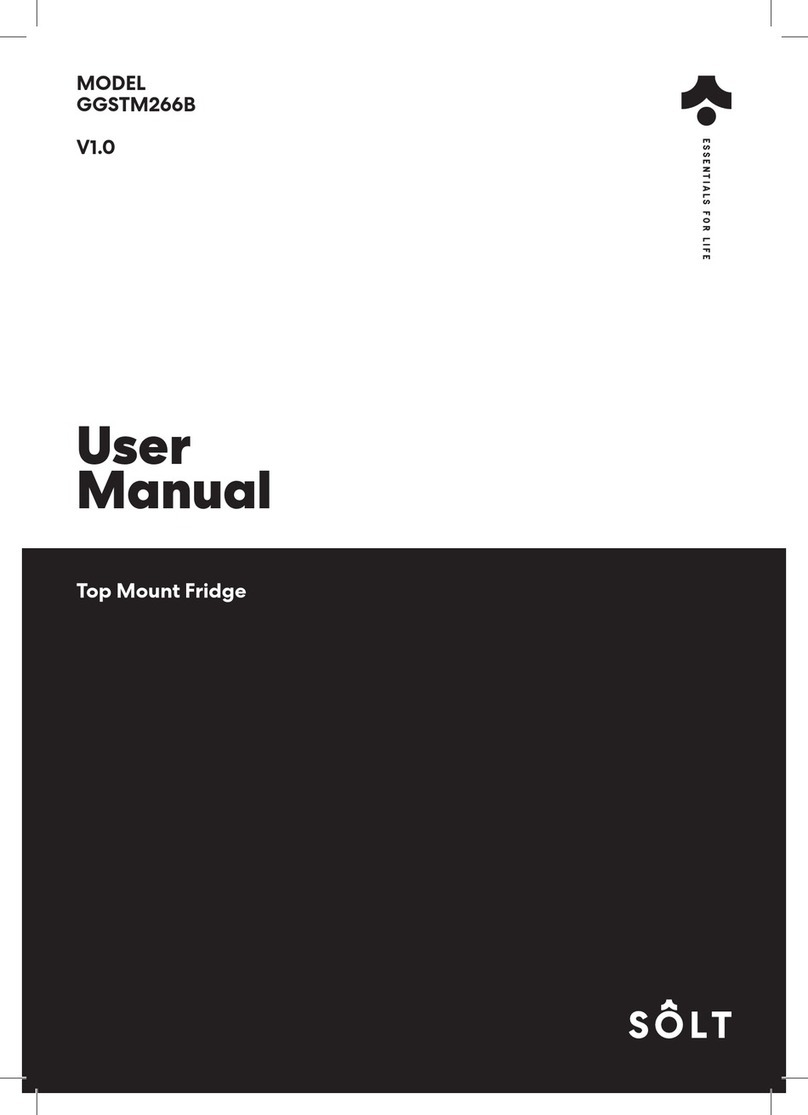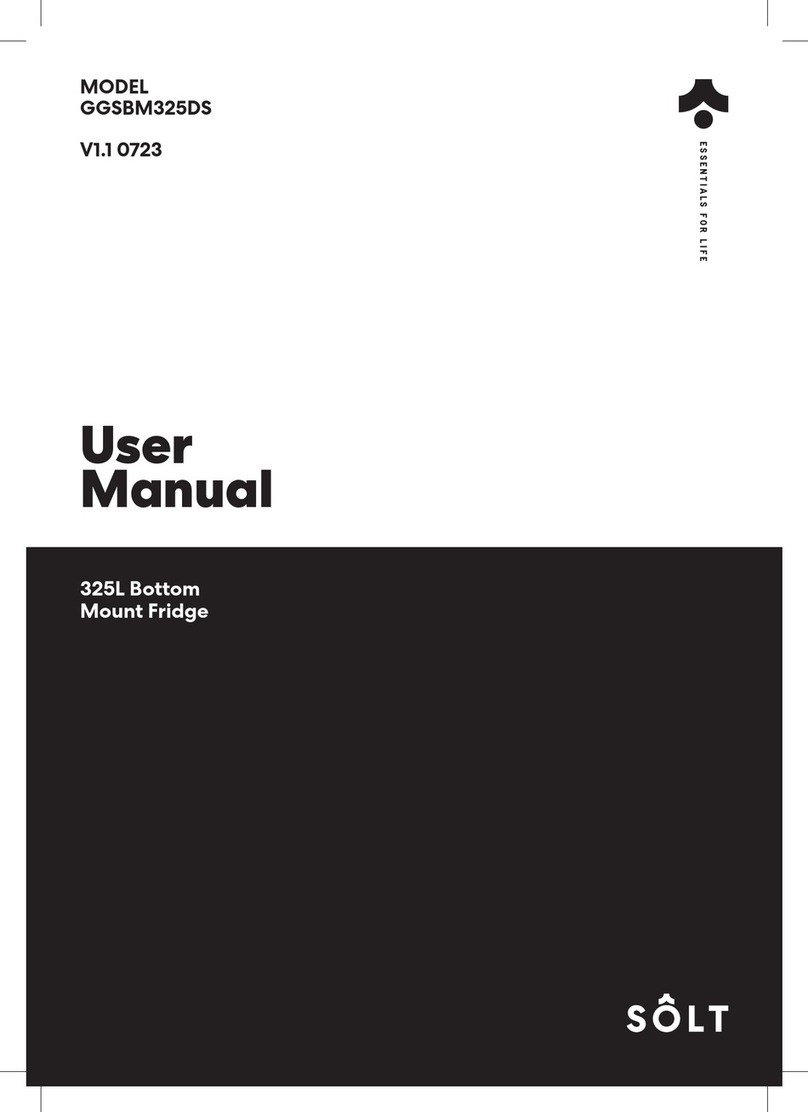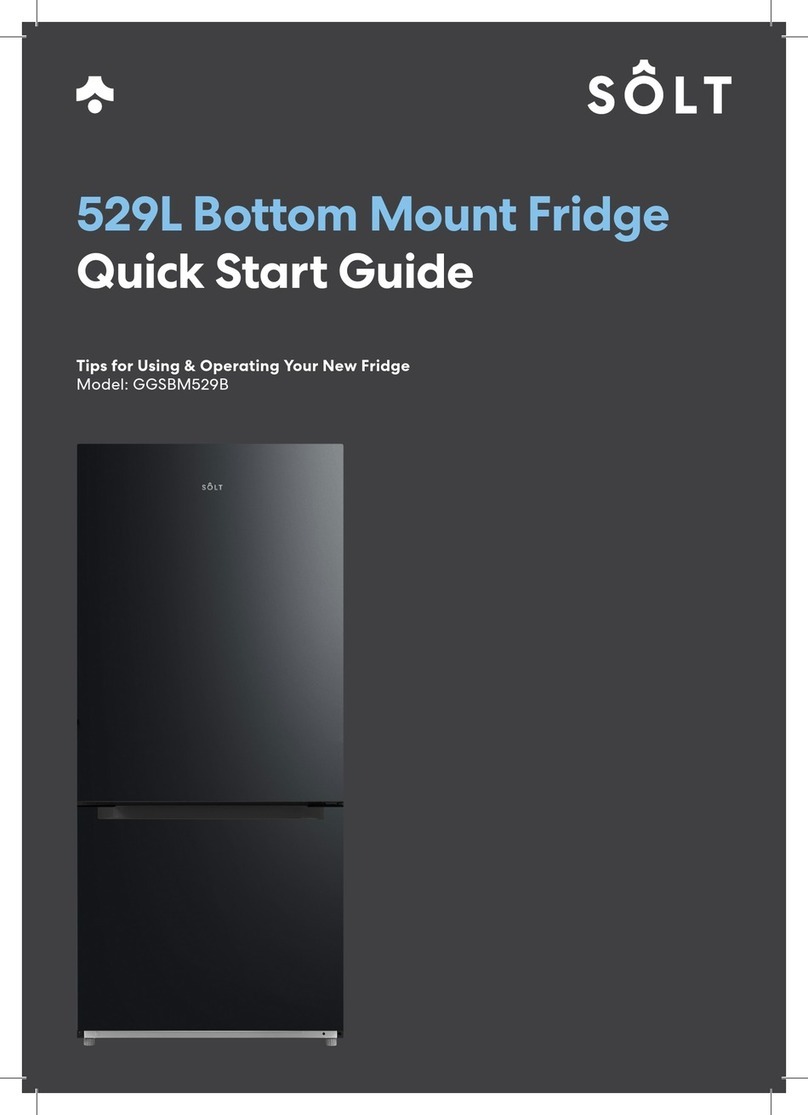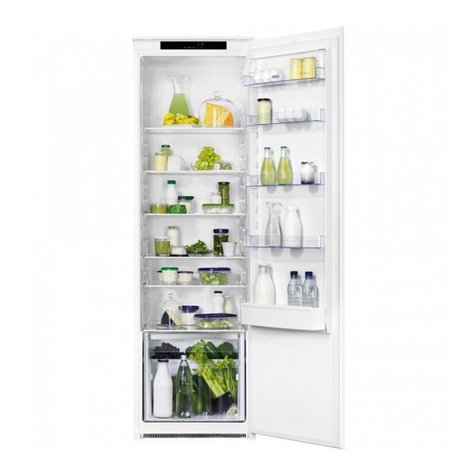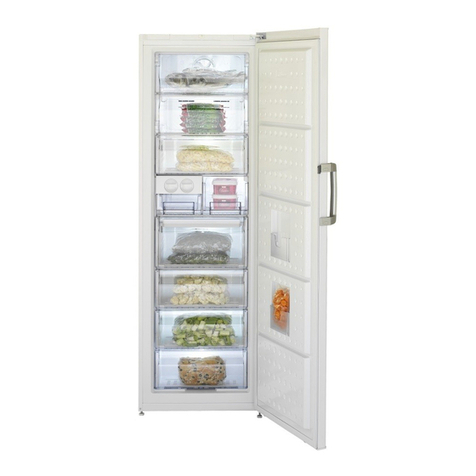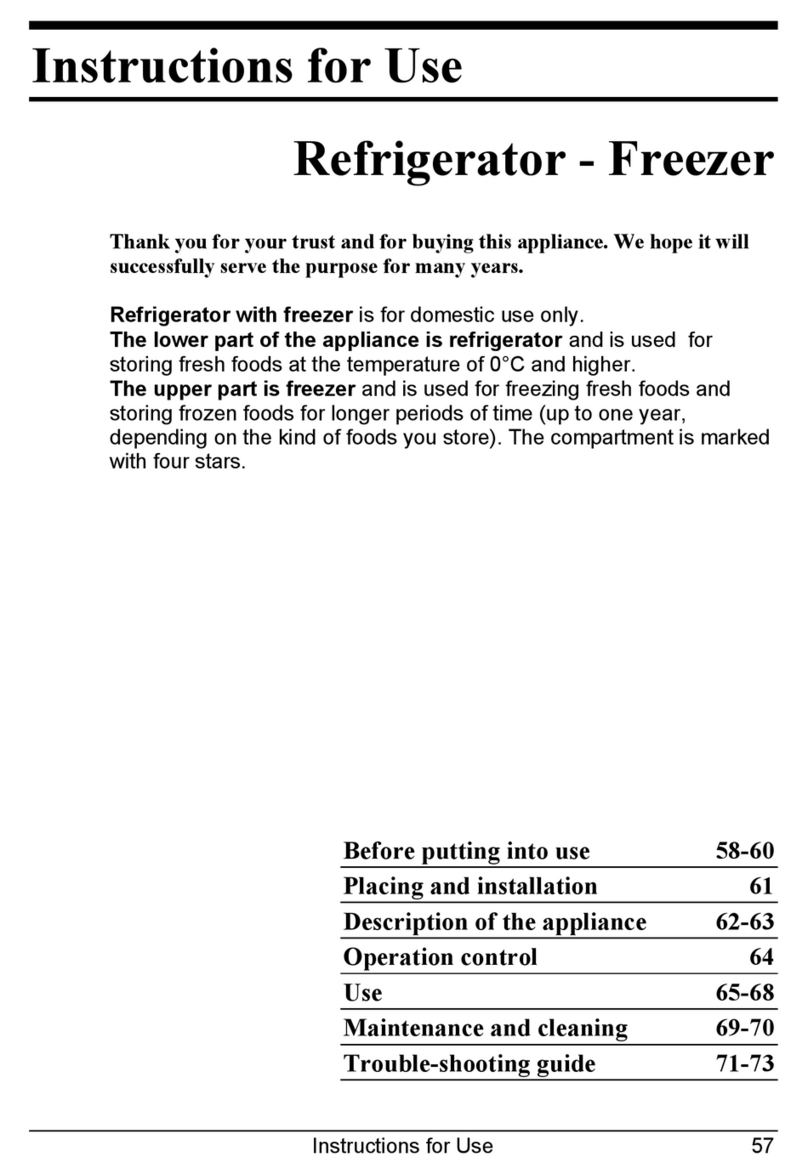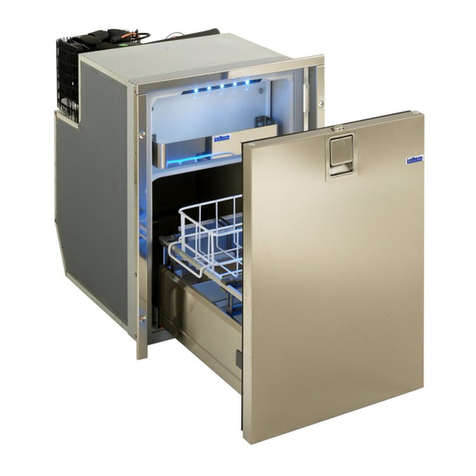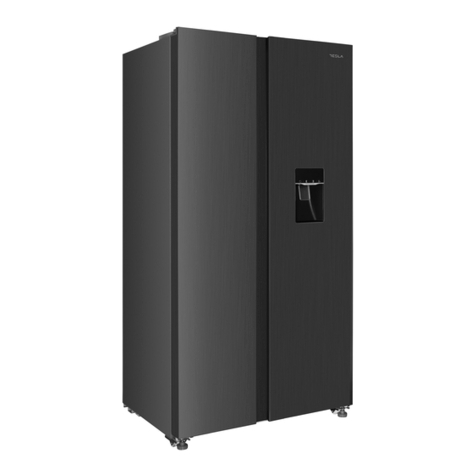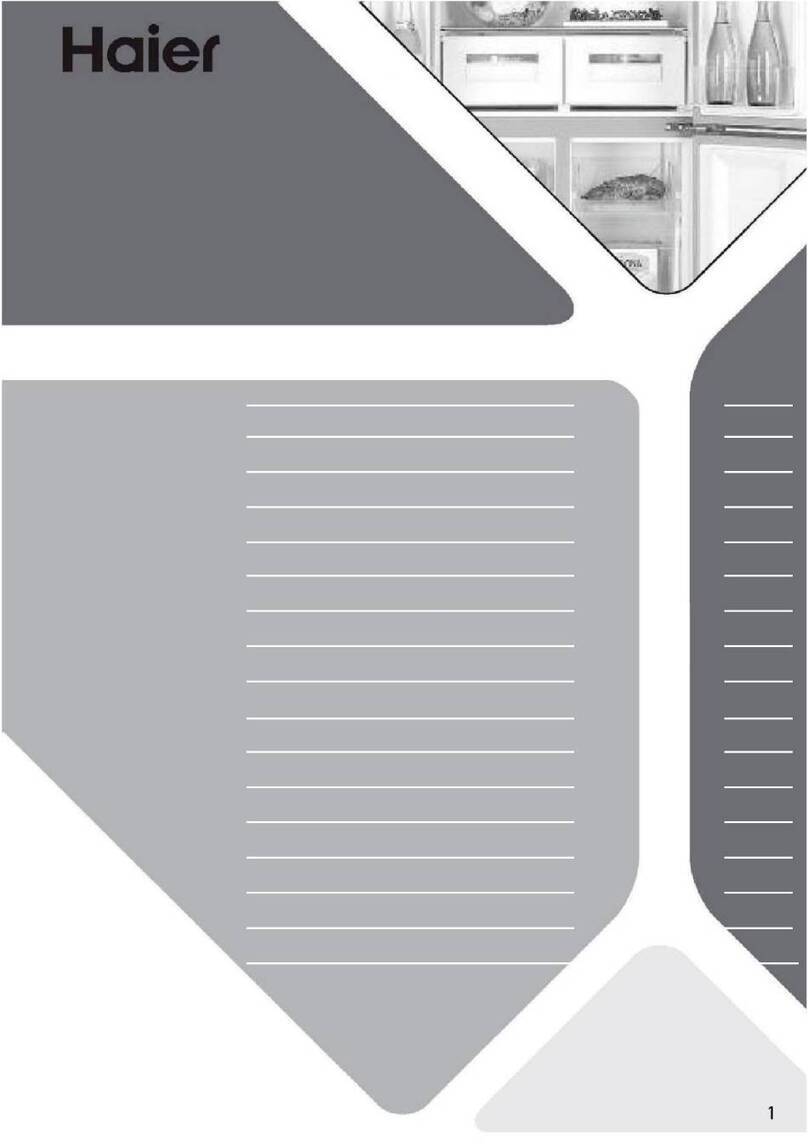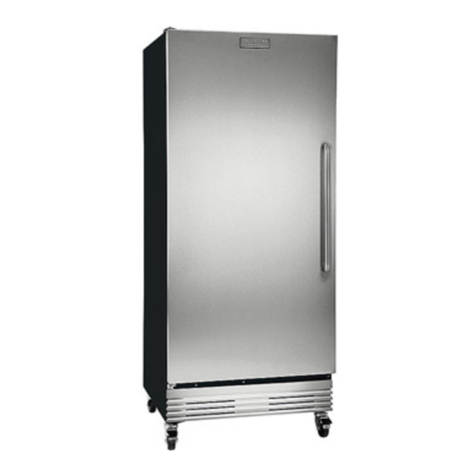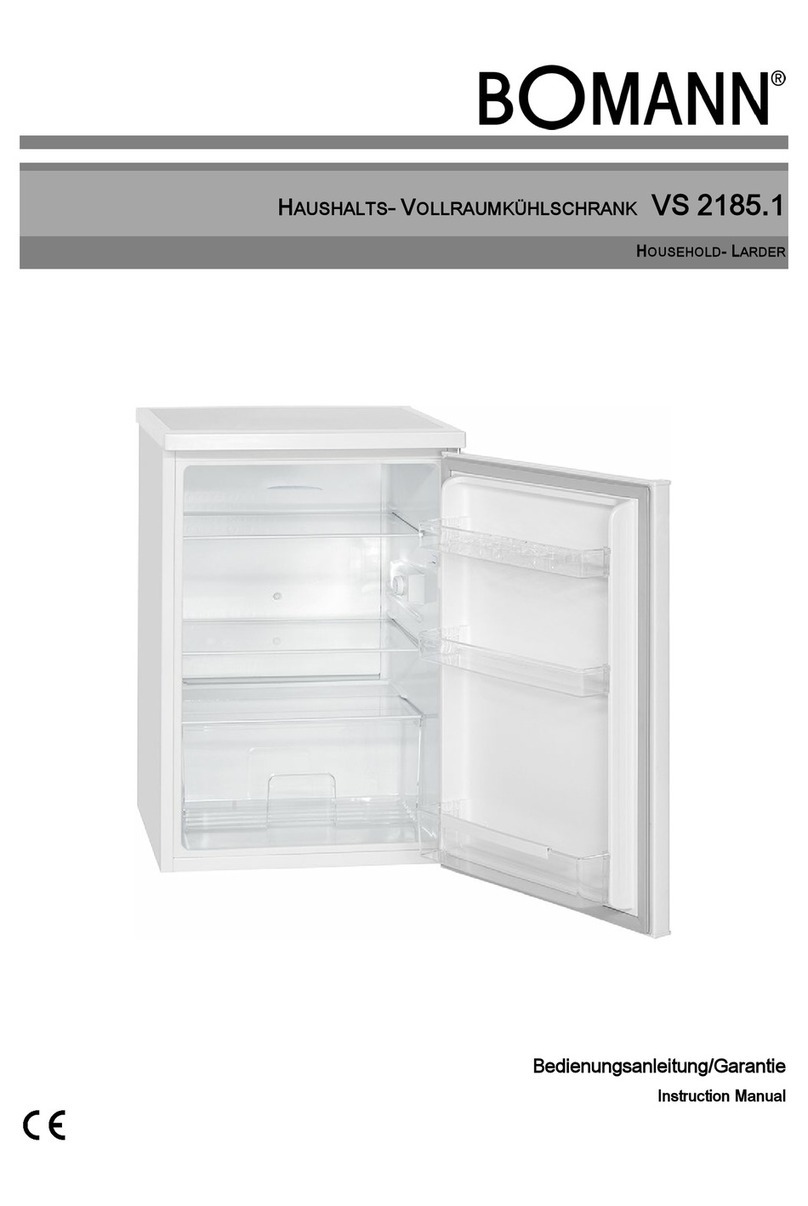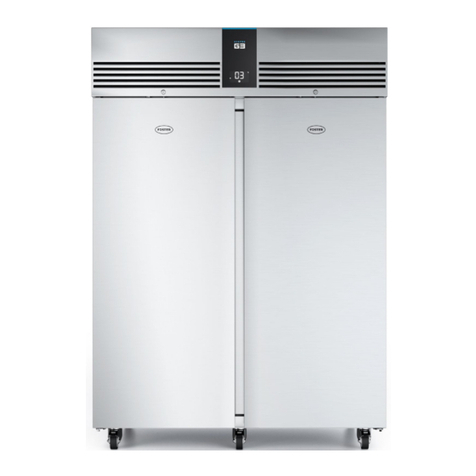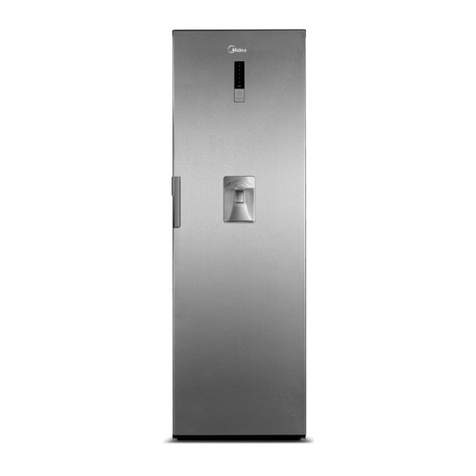Solt GGSBM325X User manual

E S S E N T I A L S FOR LIFE
User
Manual
Bottom Mount Fridge
MODEL
GGSBM325X
V1.2 0223

User Manual
2

solt.house
3
Page 4
Welcome
Page 5
Safety Warnings
Page 8
Product Overview
Page 9
Getting Started
Page 9
Installation
Page 13
Using Your
Refrigerator
Page 17
Usage Tips
Page 17
Energy Saving Tips
Page 18
Maintenance
and Cleaning
Page 20
FAQs and
Troubleshooting
Page 22
Technical
Specications
Page 23
Purchase Details
Page 23
Your Receipt
Page 24
Warranty
Information
Contents

User Manual
4
Welcome
Congratulations on purchasing your new refrigerator. The Solt brand is proudly
distributed within Australia by Residentia Group Pty Ltd.
Please refer to the warranty card at the rear of this manual for information regarding your
product’s parts and labour warranty, or visit us online at: www.residentiagroup.com.au
At Residentia Group, we are customer obsessed and our Support Team are there to
ensure you get the most out of your appliance. Should you want to learn more about your
unit such as the various temperature guides or importantly taking care of the appliance,
our Support Team are here to help.
You can use our online Support Centre at any time by visiting:
→ http://support.residentiagroup.com.au
Or you can contact us via phone by dialling: 1300 11 HELP (4357).
It is important that you read through the following use and care manual thoroughly to
familiarise yourself with the installation and operation requirements of your appliance
to ensure optimum performance.
Again, thank you for choosing an Solt appliance and we look forward to being
of service to you.
Kind Regards,
The Residentia Team
Residentia Group
—
Head Office
165 Barkly Avenue
Burnley Victoria
Australia 3121
—
ACN
600 546 656
—
Online
residentia.group
www.solt.house
@solt.house
—
Postage
PO BOX 5177, Burnley
VIC Australia 3121
—
Telephone
1300 11 4357
—
Email
support@residentia.group

solt.house
5
IMPORTANT SAFETY INSTRUCTIONS
READ CAREFULLY AND KEEP FOR FUTURE REFERENCE
Read this manual thoroughly before rst use, even if you are familiar with this type of product. The safety
precautions enclosed herein reduce the risk of re, electric shock and injury when correctly adhered to.
Make sure you understand all instructions and warnings.
Keep the manual in a safe place for future reference, along with the completed warranty card and purchase
receipt. If you sell or transfer ownership of this product, pass on these instructions to the new owner.
Always follow basic safety precautions and accident prevention measures when using an electrical
appliance, including the following:
IMPORTANT: Pay particular attention to messages that contain the words DANGER,
WARNING or CAUTION. These words are used to alert you to a potential hazard that can
seriously injure you and others. The instructions will tell you how to reduce the chance of injury and let you
know what can happen if the instructions are not followed.
This symbol alerts you to take care as this appliance contains a ammable
refrigerant (isobutane) and insulation blowing gas (cyclopentane). Do not expose
it to high heat, sparks and open ames.
The refrigerant isobutane (R600a) is contained within the refrigerant circuit of
the appliance, a gas with a high level of environmental compatibility, which is
nevertheless ammable. During transportation and installation of the appliance,
ensure that none of the components of the refrigerant circuit become damaged.
WARNING Do not damage the refrigerant circuit! Never use an appliance with a damaged
refrigerant circuit! If the refrigerant circuit becomes damaged, avoid proximity to open res and all types
of heat and ignition sources. Thoroughly ventilate the room in which the appliance is located.
DANGER It is hazardous for anyone other than an authorised service person to service this appliance.
In Queensland, the authorised service person MUST hold a Gas Work Authorisation for hydrocarbon
refrigerants to carry out servicing or repairs which involve the removal of covers.
The room for installing the appliance must be at least 1m³ per 8g of refrigerant. The amount and type of
refrigerant in the appliance can be found in the Technical Specications on page 22 and on the rating plate,
found on the appliance.
Usage Conditions and Restrictions
• Domestic use only: This appliance is intended for indoor household use only. It is not intended for
commercial, industrial or outdoor use. It is not intended for use in a recreational vehicle.
• Purpose: Do not use this appliance for anything other than its intended purpose. Other uses are not
recommended and may cause re, electric shock or personal injury.
• Attachments: The use of attachments is not recommended by the appliance manufacturer and distributor
as they may be hazardous.
• Improper use: Damage due to improper use, or repairs made by unqualied personnel will void
your warranty. We assume no liability for any eventual damages caused by misuse of the product or
noncompliance with these instructions.
Safety Warnings
1 Safety warnings
1.1 WARNING
THIS appliance is intended to be used in household and similar applications such as staff kitchen
areas in shops, offices and other working environments; farm houses and by clients in hotels, motels
and other residential type environments; bed and breakfast type environments; catering and similar non-
retail applications.
THIS appliance is not intended for use by persons (including children) with reduced physical,
sensory or mental capabilities, or lack of experience and knowledge, unless they have been given
supervision or instruction concerning use of the appliance by a person responsible for their safety.)
Children should be supervised to ensure that they do not play with the appliance.
IF the supply cord is damaged, it must be replaced by the manufacturer, its service agent or similarly
qualified persons in order to avoid a hazard.
DO not store explosive substances such as aerosol cans with a flammable propellant in this
appliance.
THE appliance has to be unplugged after use and before carrying out user maintenance on the
appliance.
WARNING:Keep ventilation openings, in the appliance enclosure or in the built-in structure,
clear of obstruction.
WARNING:Do not use mechanical devices or other means to accelerate the defrosting
process, other than those recommended by the manufacturer.
WARNING:Do not damage the refrigerant circuit.
WARNING:Do not use electrical appliances inside the food storage compartments of the
appliance, unless they are of the type recommended by the manufacturer.
WARNING:Please abandon the refrigerator according to local regulators for it use flammable
blowing gas and refrigerant.
WARNING: When positioning the appliance, ensure the supply cord is not trapped or
damaged.
WARNING: Do not locate multiple portable socket-outlets or portable power supplies at the
rear of the appliance.
DO not use extension cords or ungrounded two prong adapters•••••
DANGER••Risk of child entrapment Before you throw away your old refrigerator or freezer:
• •Take off the doors
•Leave the shelves in place so that children may not easily climb inside•
THE refrigerator must be disconnected from the source of electrical supply before attempting the
installation of accessory•
Warningrisk of fire / flammable materials
:

User Manual
6
General Safety Instructions Cont.
• WARNING Do not use mechanical devices
or other means to accelerate the defrosting
process, other than those recommended by the
manufacturer.
• Usage restriction: This appliance is not intended
for use by persons (including children) with
reduced physical, sensory or mental capabilities,
or lack of experience and knowledge, unless
they have been given supervision or instructions
concerning use of the appliance by a person
responsible for their safety.
• Children: Supervise young children to ensure
they do not play with the appliance. Never allow
children to operate, climb, play with or crawl
inside the appliance.
• WARNING Do not use electrical
appliances inside the appliance, unless they are
of the type recommended by the manufacturer.
• Explosive or ammable substances: Do not store
explosive substances such as aerosol cans with a
ammable propellant in or on this appliance. Do
not store or use petrol or any other ammable
vapours and liquids in the vicinity of this or any
other appliance. Do not use such substances for
cleaning the appliance. The fumes can create a
re hazard or an explosion.
• Damage: Do not use the appliance if the power
cord, plug or the appliance itself is damaged.
If the cord is damaged, contact the after sales
support line and have the cord replaced by
qualied personnel in order to avoid a hazard.
• WARNING Do not damage the refrigerant
circuit.
• Do not modify: Do not attempt to alter or modify
this appliance in any way.
• Repair: Do not attempt to repair or replace any
part of this appliance unless it is specically
recommended in this manual. All other servicing
should be referred to a qualied technician.
Contact the after sales support line for advice.
• WARNING Do not use multiple portable
socket-outlets or portable power supplies at the rear
of appliance.
Electrical Safety
• Voltage: Before connecting and turning on the
appliance, ensure the electrical voltage and
circuit frequency correspond to that indicated on
the appliance rating label.
• Earthing: This appliance should be properly
earthed for your safety. The power cord of this
appliance is equipped with a three-prong plug
for use in standard wall outlets to minimise the
possibility of electrical shock. Do not modify the
cord and/or plug provided with the appliance.
Improper use of the earthed plug can result in the
risk of electric shock.
• Connection: This appliance requires a standard
220-240 V AC 50Hz electrical outlet. Do not
overload the electrical circuit.
• Power cord: Do not kink or damage the power
cord; do not leave it exposed or dangling. Secure
it at the back of the appliance so no one steps on
or places anything on the cord or against it. Keep
the cord out of reach of children. When moving
the appliance, make sure not to damage the
power cord.
• WARNING When positioning the
appliance, ensure the supply cord is not trapped
or damaged.
• Auxiliary Items: Do not use an inverter, adaptor
or extension cord with this appliance. If the cord
is too short, have a qualied electrician install
an outlet near the appliance. Use of an extension
cord and an inverter can negatively aect the
performance of the unit.
• Protect from moisture: To protect against the risk
of electric shock, do not immerse the unit, cord or
plug in water or spray it with any other liquid. Do
not connect or disconnect the electric plug when
your hands are wet. Turn the power switch o
before removing the plug from the socket.
• WARNING Disconnect! To reduce the risk
of re, electric shock or personal injury, always
unplug the appliance from the socket when not
in use, when moving and before cleaning or
servicing.
Never unplug the unit by pulling the power cord.
Always grip the plug rmly and pull straight out
from
the power point.
• Electrical work: Any electrical work required for
the installation of this appliance should be carried
out by a qualied electrician.
Never use this appliance with a damaged
refrigerant circuit! If the coolant circuit becomes
damaged, avoid proximity to open res and all types
of heat sources. The room in which the appliance is
located should be ventilated for a few minutes.
Safety Warnings (Continued)

solt.house
7
Installation
Heavy: This appliance is heavy, take care when
moving it. To avoid back or other injury, consider a
two person lift or mechanical aid when installing it.
Failure to do so can result in back or other injury.
Damage: When unpacking, check the appliance
carefully for damage. If it is damaged, do not install
the appliance. Contact our after sales support
centre on 1300 43 57 for advice on examination or
return of the damaged appliance.
Protect from moisture: Install the appliance in an
indoor area protected from wind, rain, water spray
or drips.
Protect from heat: Do not install the appliance
next to an oven, grill or other source of high heat,
or where it will be exposed to direct sunlight for
prolonged periods of time.
WARNING Ventilation: To ensure proper
ventilation, keep any ventilation openings, in the
appliance enclosure or in the built-in structure, clear
of obstructions. Ensure adequate air circulation
around the appliance to prevent overheating.
Level: Install the appliance level in order to ensure
proper operation.
To Avoid Food Contamination
To avoid contamination of food, please respect the
following advice:
• Opening the door for long periods can cause a
signicant increase of temperature within the
refrigerator.
• Clean surfaces regularly that can come in contact
with food and accessible drainage systems.
• Clean water tanks if they have not been used for
48 hours; ush the water system connected to a
water supply if water has not been drawn for 5
days.*
• Store raw meat and sh in suitable containers in
the refrigerator to avoid contact with other foods
or avoid dripping on other foods.
• Two-star frozen-food compartments are suitable
for storing pre-frozen food, icecream and ice
cubes.*
• One, two, and three-star compartments are not
suitable for freezing fresh food.*
• If the appliance is left empty for long periods,
switch o, defrost, clean, dry and leave the door
open to prevent mould developing within the
appliance.
* Please conrm whether it is appliance according
to your appliance model and compartment type.
Cleaning and Maintenance
Disconnect: Unplug the appliance before cleaning
or servicing. Failure to do so can result in electric
shock, injury or death. Do not connect or disconnect
the plug when your hands are wet.
Flames: Do not let open ames or ignition sources
enter the appliance.
Flammable/explosive substances: Never clean this
appliance with ammable uids. Do not store or
use volatile, ammable or explosive propellants or
liquids in or close to this or any other appliance. The
fumes can create a re hazard or explosion.
Solvents: Do not use solvent based cleaning agents
or abrasives on the interior as these may damage or
discolour the surfaces of the appliances.
WARNING! Do not use mechanical devices
or other means to accelerate the defrosting process.
Never use a sharp or metal instrument to remove
frost or clean the appliance. Use a plastic scraper, if
necessary.
Service: Do not attempt to repair, modify or
replace any part of the appliance unless specically
recommended in this manual. Refer all other
servicing to a qualied technician, or contact the
after sales support line for advice on examination or
repair of the appliance.
Responsible disposal
Note: At the end of its working life, do not throw
this appliance out with your household rubbish.
Electrical and electronic products contain
substances that can have a detrimental eect on
the environment and human health if disposed
of inappropriately. Observe any local regulations
regarding the disposal of electrical consumer goods
and dispose of it appropriately for recycling and
recovery of the refrigerant and blowing agent.
Contact your municipal authorities for advice on
recycling facilities in your area.
WARNING! This refrigeration appliance
contains ammable refrigerants and insulation
blowing gases, which must be removed before
disposal. Contact your municipal authorities for
any codes or regulations concerning the disposal
of such materials.
1.6 Warnings for energy
Freezing chamber
1.7 Warnings for disposal
5
Do not store beer, beverage or other fluid contained in bottles or
enclosed containers in the freezing chamber of the refrigerator; or
otherwise the bottles or enclosed containers may crack due to
freezing tocause damages.
Warning for energy
1)Refrigerating appliances might not operate consistently (possibility of defrosting of contents or
temperature becoming too warm in the frozen food compartment) when sited for an extended
period of time below the cold end of the range of temperatures for which the refrigerating
appliance is designed.
2)The fact that effervescent drinks should not be stored in food freezer compartments or cabinets
or in low-temperature compartments or cabinets, and that some productssuch as water ices
should not be consumed too cold;
3)The need to not exceed the storage time(s) recommended by the food manufacturers for any
kind of food and particularly for commercially quick-frozen food in food-freezer and frozen-food
storage compartments or cabinets;
4)The precautions necessary to prevent an undue rise in the temperature of the frozen food
while defrosting the refrigerating appliance, such as wrapping the frozen food in several layers
of newspaper.
5)The fact that a rise in temperature of the frozen food during manual defrosting, maintenance or
cleaning could shorten the storage life.
6)The necessity that, for doors or lids fitted with locks and keys, the keys be kept out of the reach
of children and not in the vicinity of the refrigerating appliance, in order to prevent children from
being locked inside.
Refrigerant and cyclopentane foaming material used for the refrigerator are
flammable. Therefore, when the refrigerator is scrapped, it shall be kept away
from any fire source and be recovered by a special recovering company with
corresponding qualification other than be disposed by combustion, so as to
prevent damage tothe environment or any other harm.
When the refrigerator is scrapped, disassemble the doors, and remove gasket of
door and shelves; put the doors and shelves in a proper place, so as to prevent
trapping of any child.
Correct Disposal of this product:
This marking indicates that this product should not be disposed with other
household wastes. To prevent possible harm tothe environment or human health
from uncontrolled waste disposal, recycle it responsibly to promote the sustainable
reuse of material resources. To return your used device, please use the return and
collection systems or contact the retailer where the product was purchased. They
can take this product for environmental safe recycling.

User Manual
8
1
4
5
6
3
2
1. Temperature control panel
2. Glass shelves (×2)
3. Humidity control
4. Fruit & vegetables crisper drawer
5. Flex-zone lower drawer
6. Adjustable foot
7. Top hinge assembly
8. Door trays (various)
9. Large freezer drawer
10. Freezer drawer
11. Bottom hinge assembly + foot
Key:
8
9
10
7
11
Product Overview
Your Refrigerator
The images in this user manual are for demonstration purposes only. Your fridge may appear dierently.

solt.house
9
Getting Started
Installation
Unpacking
• Packaging materials: This appliance has been packaged to protect it against transportation damage.
Remove all packaging materials from around and inside the appliance and keep the original packaging
carton and materials in a safe place. It will help prevent any damage if the product needs to be
transported in the future, and you can use it to store the appliance when it is not in use. In the event the
carton is to be disposed of, please recycle all packaging materials where possible.
•
WARNING Suocation: Plastic wrapping can be a suocation hazard for babies and young
children, so ensure all packaging materials are out of their reach and disposed of safely.
• Power cord: Unwind the power cord to its full length and inspect it for damage. Do not use the appliance
if it or its cord have been damaged or are not working properly. In case of damage, contact our after sales
support line for advice on examination, repair or return of the damaged product.
• Read the manual: Read this manual to familiarise yourself with the appliance. Pay particular attention to
the safety instructions on the previous pages.
• Clean: To remove any dust from transit and storage, clean the interior and exterior surfaces of the
appliance with lukewarm water and a soft cloth. Dry thoroughly. Important: do not use harsh or abrasive
detergents or powders as these will damage the nish.
• Two person installation: Use two or more people to move and install the appliance. Failure to do so can
result in back or other injury.
• Freestanding design: This appliance is designed to be freestanding only, and should not be recessed
or built-in.
• Floor surface: This appliance must be properly positioned on a dry, sturdy, level surface that is strong
enough to support it when it is fully loaded.
• Ambient temperature: The ambient temperatures must correspond to the climate class (
T ) indicated on
the rating plate of the appliance: 16°C – 38°C
• Clearances: Ensure that air can circulate freely around the back of the cabinet,
which is necessary to cool the compressor and condenser. Allow at least 10cm
clear space at the back, 10cm at the sides of the unit and 30cm between the top
and any surface above (i.e. a cabinetry). If you are installing your refrigerator next
to a xed wall, leave sucient space on the hinge side to allow for the door to
swing open.
Do NOT install/use the appliance in the following locations/situations:
• In moist areas or areas of high humidity.
• In a recreational vehicle, or for use with an inverter.
• In direct sunlight, near heat sources, next to an open ame, cooking or heating appliance, or near any
other source of high heat.
• Direct sunlight may aect the acrylic coating and heat sources may increase the unit’s power
consumption. For best energy eciency install the appliance in the coolest area of the room.
• In an area with extreme cold ambient temperatures.
• In an area with excessive moisture and high humidity. Make sure it is protected from elements such as
wind, rain, water spray or drips.
• In an area where petrol or other explosive and/or ammable liquids or fumes are used or stored. The
fumes can create a re hazard or explosion.
2 1 P lacement.
2Proper use of refrigerator
6
Before use, remove all packing materials, including bottom
cushions, foam pads and tapes inside of the refrigerator; tear off
the protective film on the doors and the refrigerator body.
Keep away from heat and avoid direct sunlight. Do not place the
freezer in moist or watery places to prevent rust or reduction of
insulating effect.
Do not spray or wash the refrigerator; do not put the refrigerator
in moist places easy to be splashed with water so as not to affect
the electrical insulation properties of the refrigerator.
The refrigerator is placed in a well-ventilated indoor place; the
ground shall be flat, and sturdy (rotate left or right to adjust the
wheel for levelling if unstable).
The top space of the refrigerator shall be greater than 30cm, and
the refrigerator should be placed against a wall with a free
distance more than 10cm tofacilitate heat dissipation.
Precautions before installation:
Before installation or adjusting of accessories, it shall be ensured that the refrigerator is
disconnected from power.
Precautions shall be taken to prevent fall of the handle from causing any personal injury.
30mm
10mm
10mm
Spare enough space for convenient opening of the doors and drawers
or statement by the distributor.

User Manual
10
Installation Cont.
Electrical connection
• WARNING It must be possible to disconnect the appliance from the mains power supply; the
plug must therefore be easily accessible after installation.
• Before plugging in your fridge, let it stand upright for at least 2 hours. This will allow the refrigerant
gases to settle into the compressor and reduce the possibility of a malfunction in the cooling system.
• The appliance must be earthed. The plug of the power supply cord is equipped with a contact for this purpose.
Do not under any circumstances cut or remove the third (earth) prong from the power cord. If the plug does not
t your outlet, consult a licensed electrician for advice to have the outlet changed.
• Plug the unit into a dedicated, properly earthed wall outlet. Ensure that your outlet voltage and circuit
frequency correspond to the voltage stated on the rating label.
• Secure the fridge’s supply cord behind the unit. Do not leave it exposed or dangling to prevent injury
and accidental disconnection from the power supply.
• When rst starting up, and after a period out of use, allow the unit to cool down for at least 2–3 hours
(4 hours if starting up during warm weather in summer) before placing food in the fridge.
Levelling the Fridge
Precautions before levelling the fridge:
• Ensure that the fridge is disconnected from
the power source
• Make precautions to prevent any personal injury.
Adjusting procedures:
a. Turn the feet clockwise to raise the refrigerator;
b. Turn the feet counterclockwise to lower the refrigerator;
c. Adjust both feet so the refrigerator is level.
Installation (Continued)
Raise
Lower
Note:
The images and diagrams in this user manual are for reference only. Your appliance may appear dierently.

solt.house
11
Reversing the Door
Before your begin, power o the appliance before reversing the door and remove all food
from the door storage.
Tools required:
Cross screwdriver Putty knife or 5/6” socket Masking tape
thin-blade screwdriver and ratchet
Parts involved when reversing the door:
Part Note
1 × Right upper hinge Pre-installed on the refrigerator.
Remove when the door is reversed and keep for future use.
1 × Right upper hinge cover Pre-installed on the refrigerator.
Remove when the door is reversed and keep for future use.
1 × Decorative cover Pre-installed on the refrigerator.
Still in use when door is reverse.
1 × Stopper Pre-installed on the refrigerator.
Still in use when door is reverse.
1 × Stopper lower hinge Pre-installed on the refrigerator.
Still in use when door is reverse.
1 × Left decorative cover Pre-installed on the refrigerator.
Still in use when door is reverse.
1 × Left upper hinge In the attached plastic bag.
Take out for door reversal.
1 × Left upper hinge cover In the attached plastic bag.
Take out for door reversal.
1 × Right decorative cover In the attached plastic bag.
Take out for door reversal.
Cross screwdriver
List of tools to be provided by the user
socket and ratchetMasking tape
Putty knife
thin-blade screwdriver
Parts to be used for door reverse
Number
Name
Quantity
1
1
1
1
1
1
1
1
1
1
2
3
4
5
6
Right upper hinge
Upper right hinge
cover
Decorative cover
Stopper
Stopper Lower
hinge
Pre-installed on the refrigerator, removed when the door
is reversed, and kept for future use
Pre-installed on the refrigerator, still used when door
is reversed
Note
Pre-installed on the refrigerator, removed when the door
is reversed, and kept for future use
Pre-installed on the refrigerator, still used when door
is reversed
Pre-installed on the refrigerator, still used when door
is reversed
In the attached plastic bag, take them out for use
when door is reversed
8
9
Left upper hinge
Upper left hinge
cover
In the attached plastic bag, take them out for use
when door is reversed
In the attached plastic bag, take them out for use
when door is reversed
7
Left decorative
cover
Right decorative
cover
Pre-installed on the freezer, still used when door
is reversed
2.3 Door Right-Left Change
2.2 Leveling feet
Schematic diagram of the leveling feet
Adjusting procedures:
a. Turn the feet clockwise to raise the refrigerator;
b. Turn the feet counterclockwise to lower the refrigerator;
c. Adjust the right and left feet based on the procedures above to a horizontal level.
(The picture above is only for reference.The actual configuration will depend on the physical product
or statement by the distributor)
5/16″
Cross screwdriver
List of tools to be provided by the user
socket and ratchetMasking tape
Putty knife
thin-blade screwdriver
Parts to be used for door reverse
Number
Name
Quantity
1
1
1
1
1
1
1
1
1
1
2
3
4
5
6
Right upper hinge
Upper right hinge
cover
Decorative cover
Stopper
Stopper Lower
hinge
Pre-installed on the refrigerator, removed when the door
is reversed, and kept for future use
Pre-installed on the refrigerator, still used when door
is reversed
Note
Pre-installed on the refrigerator, removed when the door
is reversed, and kept for future use
Pre-installed on the refrigerator, still used when door
is reversed
Pre-installed on the refrigerator, still used when door
is reversed
In the attached plastic bag, take them out for use
when door is reversed
8
9
Left upper hinge
Upper left hinge
cover
In the attached plastic bag, take them out for use
when door is reversed
In the attached plastic bag, take them out for use
when door is reversed
7
Left decorative
cover
Right decorative
cover
Pre-installed on the freezer, still used when door
is reversed
2.3 Door Right-Left Change
2.2 Leveling feet
Schematic diagram of the leveling feet
Adjusting procedures:
a. Turn the feet clockwise to raise the refrigerator;
b. Turn the feet counterclockwise to lower the refrigerator;
c. Adjust the right and left feet based on the procedures above to a horizontal level.
(The picture above is only for reference.The actual configuration will depend on the physical product
or statement by the distributor)
5/16″
Cross screwdriver
List of tools to be provided by the user
socket and ratchetMasking tape
Putty knife
thin-blade screwdriver
Parts to be used for door reverse
Number
Name
Quantity
1
1
1
1
1
1
1
1
1
1
2
3
4
5
6
Right upper hinge
Upper right hinge
cover
Decorative cover
Stopper
Stopper Lower
hinge
Pre-installed on the refrigerator, removed when the door
is reversed, and kept for future use
Pre-installed on the refrigerator, still used when door
is reversed
Note
Pre-installed on the refrigerator, removed when the door
is reversed, and kept for future use
Pre-installed on the refrigerator, still used when door
is reversed
Pre-installed on the refrigerator, still used when door
is reversed
In the attached plastic bag, take them out for use
when door is reversed
8
9
Left upper hinge
Upper left hinge
cover
In the attached plastic bag, take them out for use
when door is reversed
In the attached plastic bag, take them out for use
when door is reversed
7
Left decorative
cover
Right decorative
cover
Pre-installed on the freezer, still used when door
is reversed
2.3 Door Right-Left Change
2.2 Leveling feet
Schematic diagram of the leveling feet
Adjusting procedures:
a. Turn the feet clockwise to raise the refrigerator;
b. Turn the feet counterclockwise to lower the refrigerator;
c. Adjust the right and left feet based on the procedures above to a horizontal level.
(The picture above is only for reference.The actual configuration will depend on the physical product
or statement by the distributor)
5/16″
Cross screwdriver
List of tools to be provided by the user
socket and ratchetMasking tape
Putty knife
thin-blade screwdriver
Parts to be used for door reverse
Number
Name
Quantity
1
1
1
1
1
1
1
1
1
1
2
3
4
5
6
Right upper hinge
Upper right hinge
cover
Decorative cover
Stopper
Stopper Lower
hinge
Pre-installed on the refrigerator, removed when the door
is reversed, and kept for future use
Pre-installed on the refrigerator, still used when door
is reversed
Note
Pre-installed on the refrigerator, removed when the door
is reversed, and kept for future use
Pre-installed on the refrigerator, still used when door
is reversed
Pre-installed on the refrigerator, still used when door
is reversed
In the attached plastic bag, take them out for use
when door is reversed
8
9
Left upper hinge
Upper left hinge
cover
In the attached plastic bag, take them out for use
when door is reversed
In the attached plastic bag, take them out for use
when door is reversed
7
Left decorative
cover
Right decorative
cover
Pre-installed on the freezer, still used when door
is reversed
2.3 Door Right-Left Change
2.2 Leveling feet
Schematic diagram of the leveling feet
Adjusting procedures:
a. Turn the feet clockwise to raise the refrigerator;
b. Turn the feet counterclockwise to lower the refrigerator;
c. Adjust the right and left feet based on the procedures above to a horizontal level.
(The picture above is only for reference.The actual configuration will depend on the physical product
or statement by the distributor)
5/16″

User Manual
12
Reversing the Door Cont.
1. Remove the upper left hinge cover decorative cover, upper right hinge cover and upper right hinge
2. Remove the refrigerator door (be careful not to lose small parts such as the shaft sleeve and stop on the
door); Remove the middle hinge and remove the decorative cover of hinge hole on the other side.
3. Remove the freezer door (be careful not to lose small parts such as the shaft sleeve and stop on the door);
Remove the hinge and adjust the angle. Remove and install the lower hinge shaft to the other side of the
hinge, and install the modied lower hinge to the other side of the box.
Installation (Continued)
The images in this user manual are for demonstration purposes only. Your fridge may appear dierently.
8
Stopper Lower hinge
Upper right hinge cover
decorative cover
Right upper hinge
middle hinge
hole cover
1. Please power off this appliance before conduct this operation. Remove all food from door shelves.
2. Remove the upper left hinge cover decorative cover, upper right hinge cover and upper right hinge;
3. Remove the refrigerated door body (be careful not to lose small parts such as the shaft sleeve and
stop on the door);
Remove the middle hinge and remove the decorative cover of hinge hole on the other side.
4. Remove the freezing door body (be careful not to lose small parts such as the shaft sleeve and stop
on the door);
Remove the hinge and adjust the angle. Remove and install the lower hinge shaft to the other side of
the hinge, and install the modified lower hinge to the other side of the box.
8
Stopper Lower hinge
Upper right hinge cover
decorative cover
Right upper hinge
middle hinge
hole cover
1. Please power off this appliance before conduct this operation. Remove all food from door shelves.
2. Remove the upper left hinge cover decorative cover, upper right hinge cover and upper right hinge;
3. Remove the refrigerated door body (be careful not to lose small parts such as the shaft sleeve and
stop on the door);
Remove the middle hinge and remove the decorative cover of hinge hole on the other side.
4. Remove the freezing door body (be careful not to lose small parts such as the shaft sleeve and stop
on the door);
Remove the hinge and adjust the angle. Remove and install the lower hinge shaft to the other side of
the hinge, and install the modified lower hinge to the other side of the box.
8
Stopper Lower hinge
Upper right hinge cover
decorative cover
Right upper hinge
middle hinge
hole cover
1. Please power off this appliance before conduct this operation. Remove all food from door shelves.
2. Remove the upper left hinge cover decorative cover, upper right hinge cover and upper right hinge;
3. Remove the refrigerated door body (be careful not to lose small parts such as the shaft sleeve and
stop on the door);
Remove the middle hinge and remove the decorative cover of hinge hole on the other side.
4. Remove the freezing door body (be careful not to lose small parts such as the shaft sleeve and stop
on the door);
Remove the hinge and adjust the angle. Remove and install the lower hinge shaft to the other side of
the hinge, and install the modified lower hinge to the other side of the box.
Decorative cover
Hole cover
Middle hinge
Right upper hinge cover
Stopper lower hinge
Right upper hinge

solt.house
13
The images in this user manual are for demonstration purposes only. Your fridge may appear dierently.
Reversing the Door Cont.
4. Changing the refrigerator door:
Remove the cover plate of the upper end cover of the refrigeration door and the left decorative cover
Install the upper shaft sleeve and the signal line of the door body to the other side and cover the upper
end cover plate. Take out the right decorative cover from the accessory bag and install it to the other side
of the upper end cover.
5. Changing the freezing door:
Remove the shaft sleeve and cap of the upper end cover of the freezer door and install them at the left
and right swap positions. Remove the door self-locking, door stop and shaft sleeve of the freezer door,
take out the left door self-locking from the accessory bag, install it on the left side of the lower end cover
of the freezer door, change the door stop and shaft sleeve to the left side of the lower end cover of the
freezer door.
9
cover hat
shaft sleeve
Stopper
shaft sleeve
Stopper
5. Change the refrigerator door:
Remove the cover plate of the upper end cover of the refrigeration door and the left decorative cover.
Install the upper shaft sleeve and the signal line of the door body to the other side and cover the
upper end cover plate. Take out the right decorative cover from the accessory bag and install it to
the other side of the upper end cover.
6. Change the freezing door:
1) Remove the shaft sleeve and cap of the upper end cover of the freezing door and install them at
the left and right swap positions.
2) Remove the door self-locking, door stop and shaft sleeve of the freezing door, take out the left
door self-locking from the accessory bag, install it on the left side of the lower end cover of the
freezing door, change the door stop and shaft sleeve to the left side of the lower end cover of the
freezing door.
7. Install the replaced freezing door on the lower hinge, then install the middle hinge and cover the
hinge hole decorative cover.
middle hinge
decorative cover
left decorative cover
9
cover hat
shaft sleeve
Stopper
shaft sleeve
Stopper
5. Change the refrigerator door:
Remove the cover plate of the upper end cover of the refrigeration door and the left decorative cover.
Install the upper shaft sleeve and the signal line of the door body to the other side and cover the
upper end cover plate. Take out the right decorative cover from the accessory bag and install it to
the other side of the upper end cover.
6. Change the freezing door:
1) Remove the shaft sleeve and cap of the upper end cover of the freezing door and install them at
the left and right swap positions.
2) Remove the door self-locking, door stop and shaft sleeve of the freezing door, take out the left
door self-locking from the accessory bag, install it on the left side of the lower end cover of the
freezing door, change the door stop and shaft sleeve to the left side of the lower end cover of the
freezing door.
7. Install the replaced freezing door on the lower hinge, then install the middle hinge and cover the
hinge hole decorative cover.
middle hinge
decorative cover
left decorative cover
Left decorative cover Shaft sleeve
Shaft sleeve
Cover hat
Stopper
Stopper

User Manual
14
Reversing the Door Cont.
7. Install the reversed freezer door on the lower hinge, then install the middle hinge and cover the hinge hole
decorative cover.
8. Remove the upper left hinge cover and upper left hinge from the accessory bag. Place the refrigerated
door body on the middle hinge and install the upper left hinge. Finally, replace the hinge decorative cover
to the right side of the box body.
The images in this user manual are for demonstration purposes only. Your fridge may appear dierently.
9
cover hat
shaft sleeve
Stopper
shaft sleeve
Stopper
5. Change the refrigerator door:
Remove the cover plate of the upper end cover of the refrigeration door and the left decorative cover.
Install the upper shaft sleeve and the signal line of the door body to the other side and cover the
upper end cover plate. Take out the right decorative cover from the accessory bag and install it to
the other side of the upper end cover.
6. Change the freezing door:
1) Remove the shaft sleeve and cap of the upper end cover of the freezing door and install them at
the left and right swap positions.
2) Remove the door self-locking, door stop and shaft sleeve of the freezing door, take out the left
door self-locking from the accessory bag, install it on the left side of the lower end cover of the
freezing door, change the door stop and shaft sleeve to the left side of the lower end cover of the
freezing door.
7. Install the replaced freezing door on the lower hinge, then install the middle hinge and cover the
hinge hole decorative cover.
middle hinge
decorative cover
left decorative cover
Decorative cover
Middle hinge
10
2.4 Changing the Light
2.6 Energy saving tips
2.5 Starting
The appliance should be located in the coolest area of the room, away from heat producing
appliances or heating ducts, and out of the direct sunlight.
Let hot foods cool to room temperature before placing in the appliance. Overloading the appliance
forces the compressor to run longer. Foods that freeze too slowly may lose quality, or spoil.
Be sure to wrap foods properly, and wipe containers dry before placing them in the appliance.This
cuts down on frost build-up inside the appliance.
Appliance storage bin should not be lined with aluminum foil, wax paper, or paper toweling. Liners
interfere with cold air circulation, making the appliance less efficient.
Organize and label food to reduce door openings and extended searches. Remove as many items
as needed at one time, and close the door as soon as possible.
Any replacement or maintenance of the LED lamps is intended to be made by the manufacturer, its
service agent or similar qualified person.
Before putting any fresh or frozen foods, the refrigerator shall have run for
2-3 hours, or for above 4 hours in summer when the ambient temperature
is high.
8. Remove the upper left hinge cover and upper left hinge from the accessory bag.
Place the refrigerated door body on the middle hinge and install the upper left hinge.
Finally, replace the hinge decorative cover to the right side of the box body.
decorative cover
Left upper hinge
Upper left hinge cover
Please pull out the plug in case of power failure or cleaning. Do not
connect the refrigerator to power supply within five minutes to prevent
damages tothe compressor due tosuccessive starts.
After transportation, please let the product stay for more than 2 hours before
turning on the power, otherwise it will lead to a decrease in cooling capacity
or a damage to the product.
Decorative cover
Left upper hinge cover
Left upper hinge
Installation (Continued)

solt.house
15
* The temperature range is measured based on 32° C ambient temperature.
The images in this user manual are for demonstration purposes only. Your fridge may appear dierently.
Fridge Compartment
• The fridge compartment is suitable for storage of a variety of fruits, vegetabls, beverages and other foods
to be consumed in short term.
• Ensure that hot food has cooled down to room temperature before putting it into the fridge.
• Ensure that your food is sealed up before placing into the fridge.
• The glass shelves can be adjusted up and down for your convience.
Freezer Compartment
• The freezer compartment may keep food fresh for a long period of time and it is mainly used to store
frozen food and making ice.
• The freezer compartment is suitable for the storage of meat, sh, rice and other foods to be consumed in
short term.
Note: Storage of too much food during operation after the initial connection to power may adversely aect
the freeze eect of the refrigerator. Foods stored should not block the air outlet; otherwise the freezing
eect will also be adversely aected.
Temperature Contol Panel
Button A: Temperature setting button / Quick Cool
LED #1 (Cold): Setting 1 (Temperature range*: 6° C (±2° C))
LED #2 (Recommended): Setting 2 (Temperature range*: 4° C (±2° C))
LED #3 (Recommended): Setting 3 (Temperature range*: 3° C (±2° C))
LED #4 (Coldest): Setting 4 (Temperature range*: 2° C (±2° C))
Display
• When power is initially connected, all LEDs will display for 3 seconds. The refrigerator will then run at the
default setting 2.
• The LED lights will display the set refrigeration setting. In the event of a failure, a combination of LED
lights will blink. Please refer to the Fault Indication heading under FAQs and Troubleshooting section of
this user manual.
Temperature setting
Each time the temperature setting (Button A) is pressed, the temperature setting will change one
time. After the temperature setting has been completed, the refrigerator will run according to the
selected setting after 15 seconds.
Quick Cool mode
Long press the temperature setting (Button A) for 3 seconds, after LED #2 and LED #3 display for 30
seconds, it will enter into Quick Cool mode. Long press temperature setting button for 3 seconds again to
cancel Quick cool mode.
Using Your Refrigerator
4 3 2A 1

User Manual
16
Freezer temperature adjustment paddle
It is located at the lower left corner of the
refrigerator, and the default position of the paddle is
set to the right.
If the paddle is set to the far right on the Cold
setting, the temperature will be set at -15° C.
If the paddle is set in the middle, the temperature is
set at -18° C.
If the paddle is set to the far left on the Coldest
setting, the temperature will be set at -22° C.
Flex-zone drawer temperature adjustment paddle
The paddle can control the temperature of the
Flex-zone drawer. The paddle is located at the
bottom of the refrigerated air duct, and the factory
position is on the far right. Slide the paddle to the
left, and the temperature of the multifunction box
will decrease. Slide the paddle to the right, and the
temperature will increase.
Using Your Refrigerator (Continued)
13
6) Freezer temperature adjustment paddle
It is located at the lower left corner of the refrigerator, and the factory position of the paddle is on the right.
The paddle can control the temperature of the multi-function box area. The paddle is located at the bottom
of the refrigerated air duct, and the factory position is on the far right. Slide the paddle to the left, and the
temperature of the multifunction box will drop. The temperature of the multifunction box can be adjusted
by moving the position of the paddle.
If the paddle moves to the left, the temperature of the freezer compartment will increase, and if the paddle
moves to the right, the temperature of the freezer compartment will decrease.
7) Multi-function box temperature adjustment paddle
Temperature adjustment knob
Temperature adjustment slider
13
6) Freezer temperature adjustment paddle
It is located at the lower left corner of the refrigerator, and the factory position of the paddle is on the right.
The paddle can control the temperature of the multi-function box area. The paddle is located at the bottom
of the refrigerated air duct, and the factory position is on the far right. Slide the paddle to the left, and the
temperature of the multifunction box will drop. The temperature of the multifunction box can be adjusted
by moving the position of the paddle.
If the paddle moves to the left, the temperature of the freezer compartment will increase, and if the paddle
moves to the right, the temperature of the freezer compartment will decrease.
7) Multi-function box temperature adjustment paddle
Temperature adjustment knob
Temperature adjustment slider
* The temperature setting is measured based on 32° C ambient temperature.
The images in this user manual are for demonstration purposes only. Your fridge may appear dierently.

solt.house
17
• Do not store food uncovered in the fridge. Always use good quality, fridge-proof packaging to maintain
food quality. Remove air from packages of solid food and seal bags tightly before freezing.
• Keep portions small to ensure they are frozen (and subsequently defrosted) rapidly.
• Make sure that fresh, unfrozen food packages do not touch food that is already frozen, thus avoiding a
temperature rise in the frozen food.
• When freezing food, do not push food together too much, leave some space for air to circulate around
each item. Do not place packages directly against the back wall.
• When buying frozen food, only buy quantities that you can store straight away; use an insulated container
for your shopping and when you get home, place the food in the freezer compartment immediately.
• When storing pre-packed, commercially frozen food, follow the food manufacturer’s instructions for
storing the food in a home fridge or freezer. Do not exceed any storage times listed on the packaging.
• Once you have opened a packet of frozen food, re-wrap it airtight to prevent surface evaporation which
causes drying or freezer burn.
• Do not place carbonated liquids such as bottles of zzy drink in the freezer compartment as the container
could explode under pressure and damage the chiller.
• Do not refreeze food once it has been defrosted.
• Frozen food which has thawed accidentally should either be used immediately or thrown away.
Alternatively, if the food is uncooked and has not been completely defrosted, it may be cooked
and then refrozen.
• CAUTION! Do not remove items from the freezer compartment if your hands are damp or wet as this
could cause skin abrasions.
• The appliance should be placed in the coolest area of the room, away from heat producing appliances or
heating ducts. Please avoid placement in direct sunlight.
• Let hot foods cool to room temperature before placing them in the appliance.
• Do not overload the appliance with unfrozen food as this may cause it to freeze slowly and risk food spoilage.
• Be sure to wrap foods properly and wipe containers dry before placing them in the appliance. This cuts
down on frost building up inside in the unit.
• Please do not wrap items in aluminium foil, wax paper or paper towel. This materials interfere with cold air
circulation, making the appliance less ecient.
• Organise and label food to reduce door openings and extended searches. Remove as many items as needed
at one time, ensuring the unit is opened as few times as possible.
Energy Saving Tips
Usage Tips

User Manual
18
Cleaning
WARNING
Before cleaning the appliance, make sure it is switched o and disconnected from the power supply.
Failure to do so can result in electric shock or injury.
• Dust behind the refrigerator and on the ground shall be timely cleaned to improve the cooling eect
and energy saving.
• Check the door gasket regularly to make sure there are no debris. Clean the door gasket with a soft
cloth dampened with soapy water or diluted detergent.
• The interior of the refrigerator should be cleaned regularly to avoid odor.
• Please turn o the power before cleaning interior, remove all foods, drinks ,shelves, drawers, etc.
• Use a soft cloth or sponge to clean the inside of the refrigerator, with two tablespoons of baking soda
and a quart of warm water. Then rinse with water and wipe clean. After cleaning, open the door and
let it dry naturally before turning on the power.
• For areas that are dicult to clean in the refrigerator (such as narrow sandwiches, gaps or corners),
it is recommended to wipe them regularly with a soft rag, soft brush, etc. and when necessary,
combined with some auxiliary tools (such as thin sticks) to ensure no contaminants or bacterial
accumulation in these areas.
• Do not use soap, detergent, scrub powder, spray cleaner, etc., as these may cause odors in the
interior of the refrigerator or contaminated food.
• Clean the bottle frame, shelves and drawers with a soft cloth dampened with soapy water or diluted
detergent. Dry with a soft cloth or dry naturally.
• Wipe the outer surface of the refrigerator with a soft cloth dampened with soapy water, detergent,
etc, and then wipe dry.
• Do not use hard brushes, clean steel balls, wire brushes, abrasives (such as toothpastes), organic
solvents (such as alcohol, acetone, banana oil, etc.), boiling water, acid or alkaline items, which may
damage the fridge surface and interior. Boiling water and organic solvents such as benzene may
deform or damage plastic parts.
• Do not rinse directly with water or other liquids during cleaning to avoid short circuits or aect
electrical insulation after immersion.
• Never use boiling water to accelerate defrosting as it may damage the plastic components.
• After everything is dry, place appliance back into operation.
• Allow approximately 1–2 hours for the cabinet to cool down again (depending on the length of time
the appliance was disconnected from the power).
WARNING
Never clean the unit with an abrasive, acid, oil or solvent based cleaning agent. Never use ammable
uids or sprays for cleaning as the fumes from these substances can create a re hazard or Explosion.
Defrosting
The refrigerator is made based on the air-cooling principle and thus has automatic defrosting function.
Frost formed due to change of season or temperature may also be manually removed by disconnection
of the appliance from power supply or by wiping with a dry towel.
Maintenance and Cleaning

solt.house
19
Out of operation
• Power failure: Most power failures are corrected within a few hours and should not aect the
temperature of your appliance if you minimise the number of times the door is opened. If the power
is going to be o for a longer period of time, take proper steps to protect the contents.
• Long-term storage: The appliance must be unplugged and cleaned; the doors much be left open to
prevent odour.
• Moving: Before the refrigerator is moved, take all objects inside out, x the glass partitions, crisper
drawers, freezer drawers and etc. with tape, and tighten the levelling feet; close the doors and seal
them with tape. During moving, the appliance shall not be laid upside down or horizontally, or be
vibrated; the inclination during movement shall be no more than 45°.
Service, repair and spare parts
Do not attempt to alter or modify this appliance in any way, or to repair or replace any part unless
it is specically recommended in this manual. All other servicing should be referred to a qualied
technician. Contact our after sales support on 1300 11 43 57 for advice.
Our after sales support centre stocks a selection of spare parts for the Solt 325L Bottom Mount
Refrigerator. To enquire about purchasing a part, call us on 1300 11 43 57 or email

User Manual
20
Problem Possible Cause Possible Solution
The appliance
does not
operate.
• The appliance is not plugged in.
• The appliance is turned o.
• The circuit breaker tripped or a
blown fuse.
• Plug in the appliance.
• Turn on power point.
• Reset circuit breaker/replace fuse.
The appliance
has an odd
odour.
• Food may not be wrapped properly.
• Food may be rotten.
• The interior may not be clean.
• Check that the food is wrapped tightly.
• Check for rotten food and remove.
• Clean the interior of the appliance.
The compressor
is operating for
a long time
• Ambient temperature may be high.
• Too much food may be stored in the
appliance.
• Hot food is stored in the appliance.
• The doors are opened too frequently.
• This is normal, especially in summer.
• Reduce the amount of food stored in the
appliance.
• Ensure the food has cooled before
placing in the refrigerator.
• Limit the frequency of door openings.
The internal
light does not
illuminate.
• The appliance is not plugged in.
• The appliance is turned o.
• The circuit breaker tripped or a
blown fuse.
• The light is damaged.
• Plug in the appliance.
• Turn on power point.
• Reset circuit breaker/replace fuse.
• Please contact after sales support.
The door
will not close.
• The appliance is not level.
• Food is preventing door closure.
• Level the appliance.
• Re-position food so it does not obstruct.
The door
seal is loose
• Foreign matter may be on the seal
• Seal may need restoration
• Clean the door seal
• Please contact after sales support.
Water pan
overows
• Too much food may be stored in the
appliance or food may have a large
water contents resulting in heavy
defrosting.
• Door may not be closed properly.
• Reduce the amount of food stored in the
appliance.
• Close the door.
Warm or hot
housing
• Heat dissipation of the built-in
condenser via the housing may
become hot due to high ambient
temperature, storage of too much
food or not enough ventilation to
help facilitate heat dissipation.
• This is normal, especially in summer.
• Reduce the amount of food stored in the
appliance.
• Ensure the stored food allows for
eective circulation within the
refrigeration
FAQs and Troubleshooting
Other Solt Refrigerator manuals
